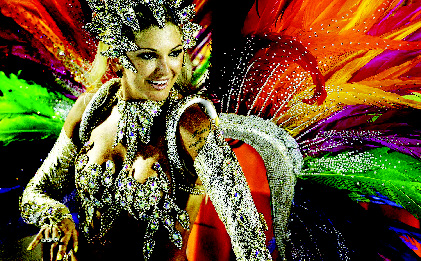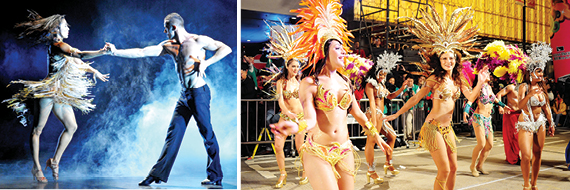

This year, that quintessential Brazilian extravaganza, the ‘Carnival’, was almost lost in the build-up to the Football World Cup. The Brazilian Carnival, a yearly ‘street’ event, best showcases ethnic Brazilian culture. It attracts thousands of visitors to the major cities of Brazil. The Carnival is celebrated before the traditional Ash Wednesday, which heralds the start of the abstinence period - forty days before Easter Sunday - as per Catholic tradition. The cities of Rio de Janeiro, Sao Paulo and Vitoria organise dancing parades – though not to be left behind are the North-Eastern cities like Olinda, Salvador, Porto Seguro and Recife. On parade in these Carnivals is the indigenous dance form of Brazil, the ‘Samba’, along with its regional variations. The Samba dancers, known as ‘Sambista’, enthrall the crowds with a pulsating display of movements. The dancers wear feathers and glittery costumes, and paint their faces and bodies in various colours, as they dance sensually while mingling with the cheering crowds in a Parade. Though now it has become popular as a ballroom dancing form in the western world, and has become a recognised performing dance in Europe, it was basically intended to be performed solo. The Ballroom Samba is performed in closed and open positions, with partners.
Samba is a rhythmic dance that has a Portuguese (erstwhile colonial ruler) influence, and is performed to local Samba music. Samba is also referred to as Roda de Danca (round dance) by the native Brazilians, who have been performing this dance in religious festivals for centuries. The Dance can be traced to the region of Bahia, where it has been performed since the 17th. century. The Portuguese colonists, marvelling at the use of drums, named the dance form ‘Samba’ - and the name has stuck. It is actually a thread of dances. The Samba dancers’ actions appear to be gentle on the knees and ankles. The effortless movement of the dancers, who turn their heads and extend their arms, follows a quick-quick-slow technique. The women dance, one after the other, encircling, moving their legs, feet and hips, and clap as they exit. There are numerous variations to the Samba style of dancing. Bantu African slaves, who were transported to South America, enhanced the Dance with a rhythm called ‘Lundu’. In the dance form ‘Umbigada’, a variation of Samba, the women, dancing in turns, follow each other to the middle of the circle. The ‘Samba no pe’ is a solo dance with slow feet movement, one bent knee and a straight body. This dance follows the musical beat of four steps per measure. The Bahia girls tilt their legs from the outside to the inside - which is a popular style seen in Brazilian carnival parades. ‘Samba de Gafiera’ is popular with the habitants of Rio de Janeiro. It is a combination of the waltz and tango and is also influenced by Argentine tango elements. ‘Samba Pagode’ is more acrobatic and is popular in the city of Sao Paulo. ‘Samba Axe’, a more recent form, is a North-Eastern style, which does not conform to the formal and traditional Samba movements. Reggae and Rock have also been introduced to Samba and are often performed at night clubs, while ‘Samba Roda’ is an Afro-Brazilian dance that involves singing, clapping and dancing. The Olinda Carnival in North-East Brazil is influenced by the ‘Frevo’ and ‘Maracatu’ (Brazilian Folk culture). The instruments used in Samba are the tamborim, chocalho, reco-reco and cabaca. The tempo of the music is about a hundred beats per minute. The genres of Samba music are the Samba-enredo, Samba de bloco, Samba de embalo, Frevo, Maracatu, Samba-reggae and Axe. Samba truly celebrates the joy of dancing for the fun of it!
The Writer is a renowned Kuchipudi Danseuse and Choreographer
Read More...